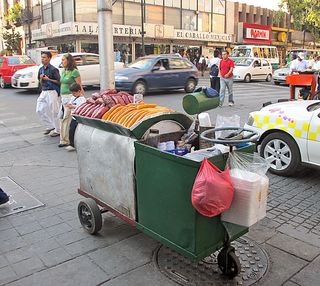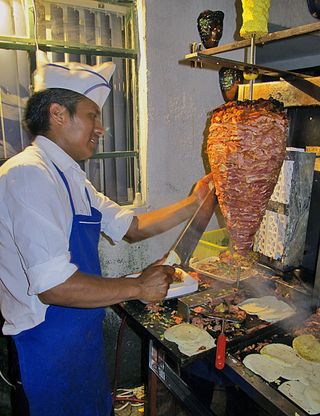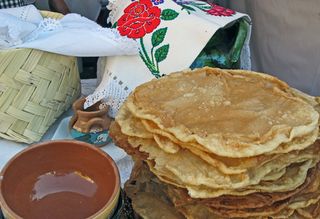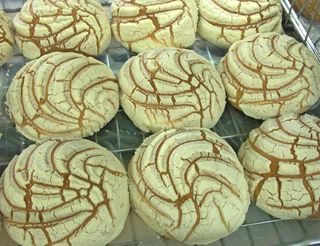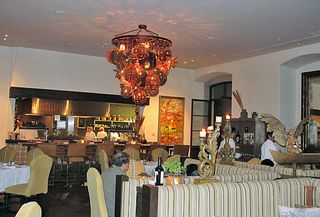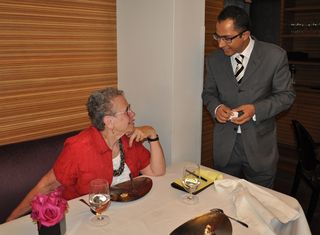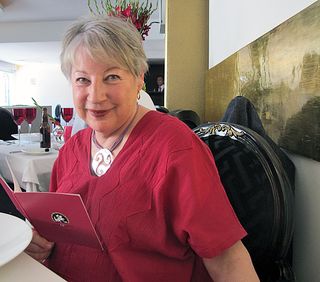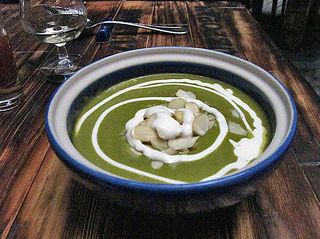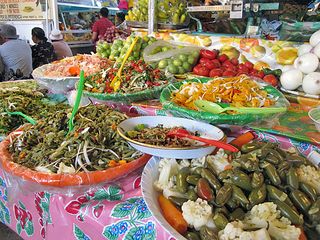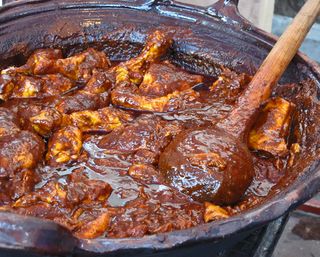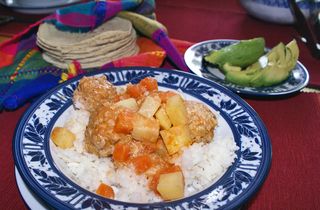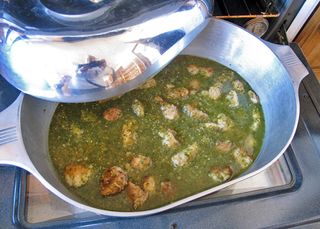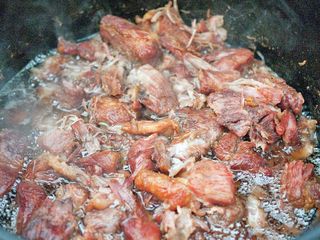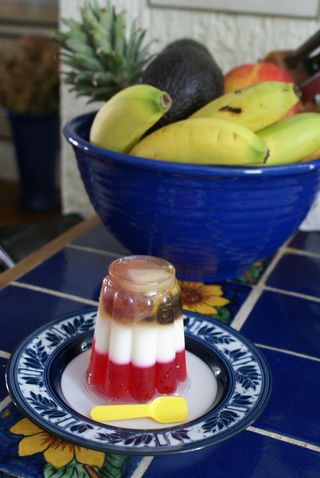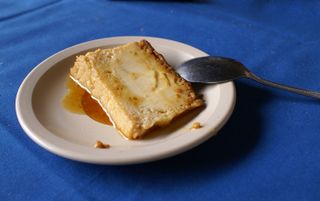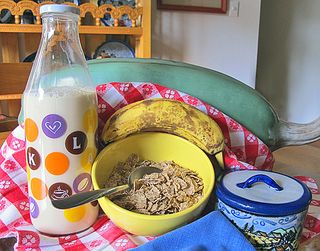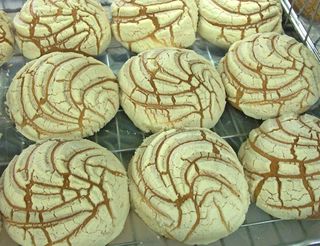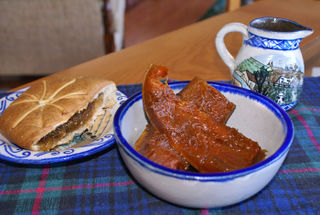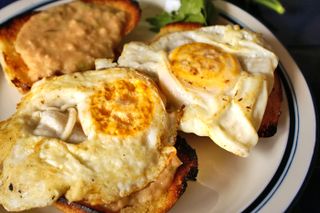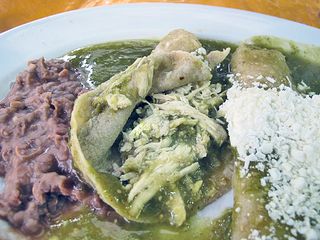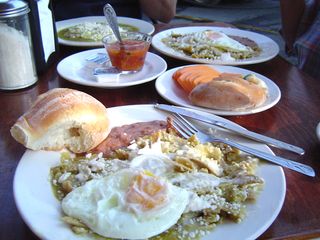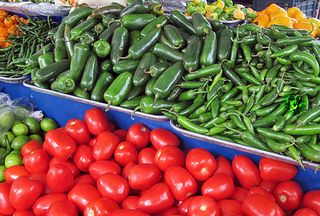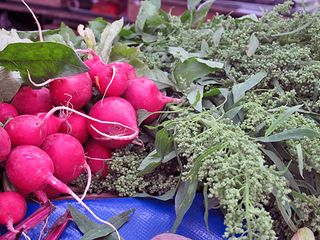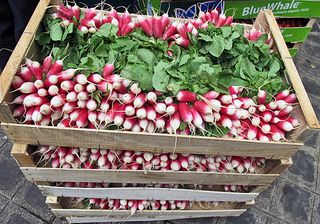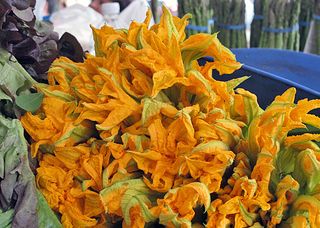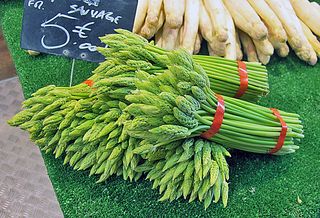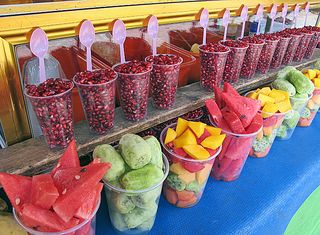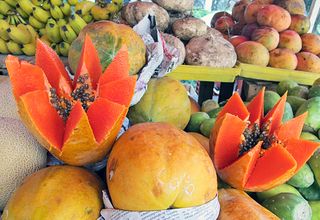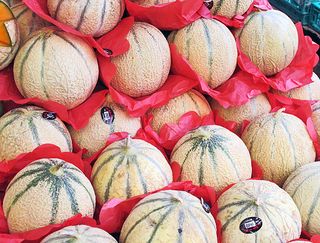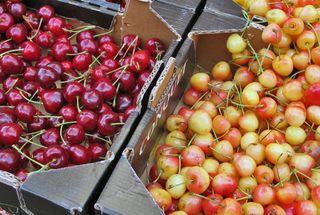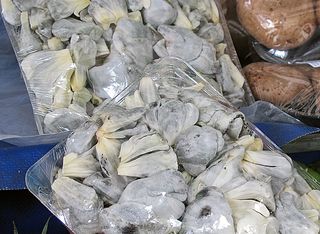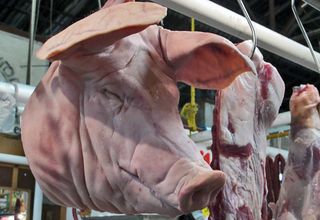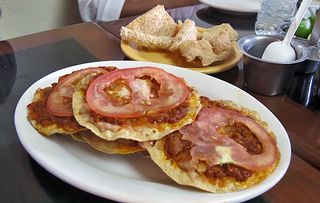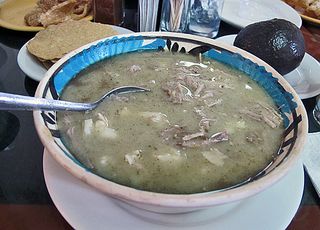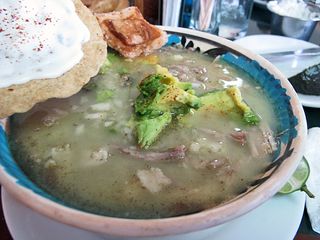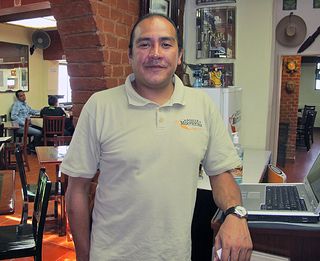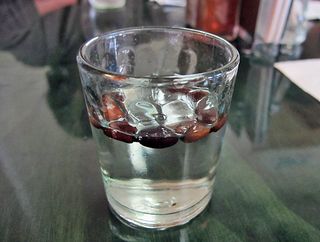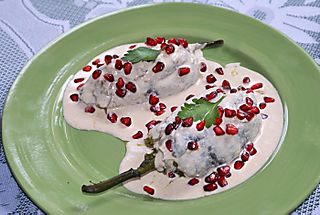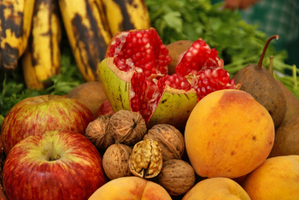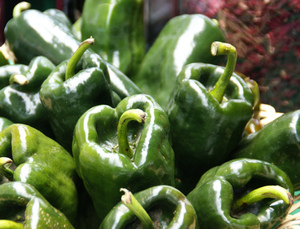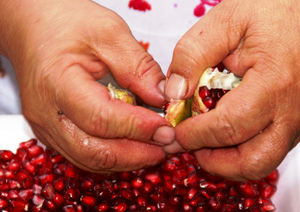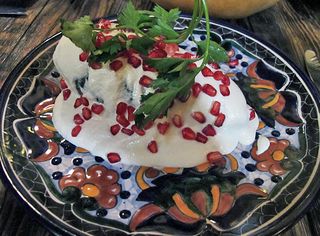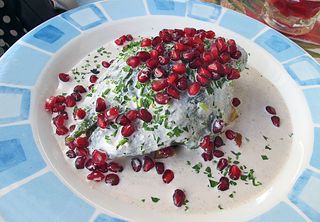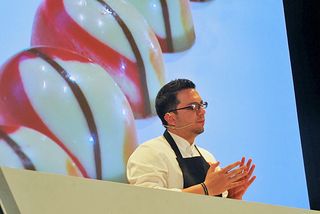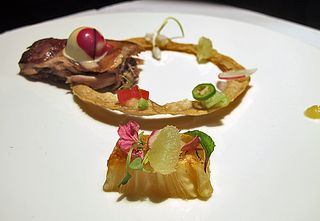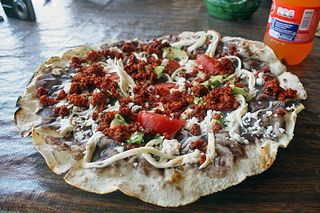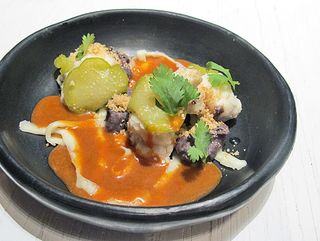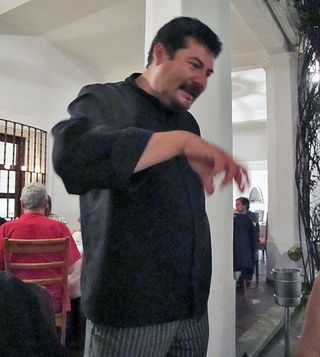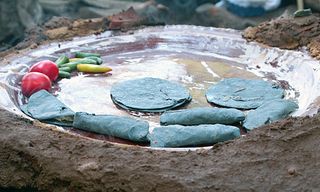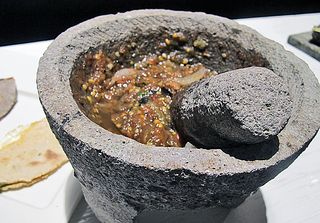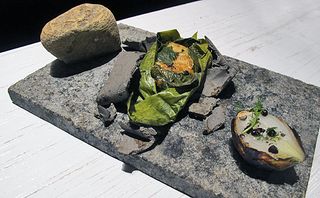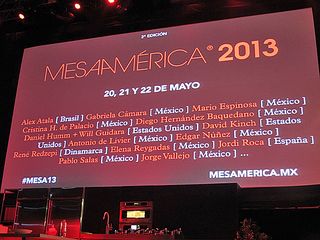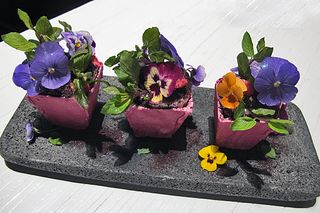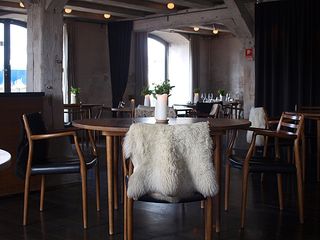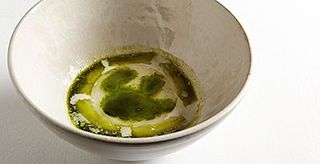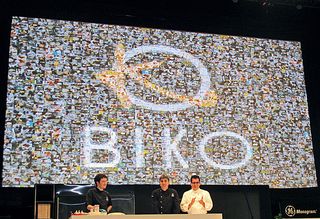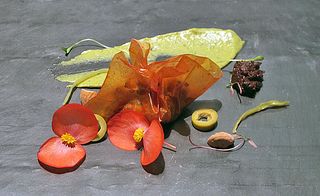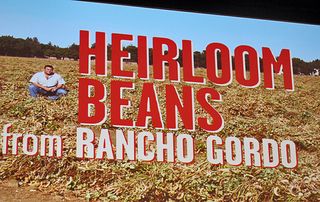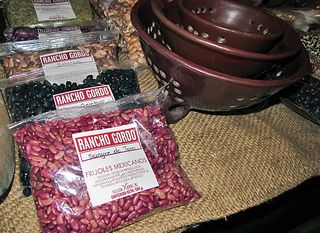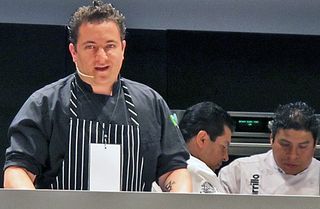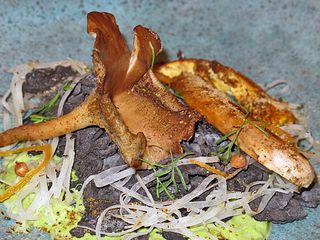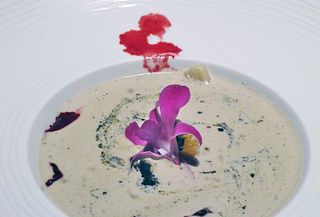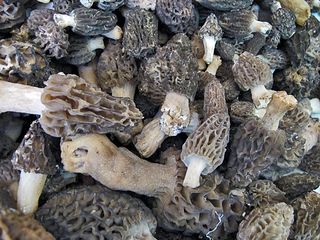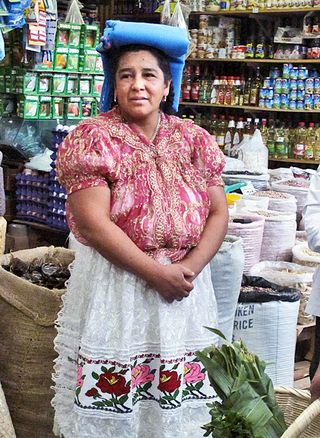
Many people–Mexico Cooks! included–believe that maestra Benedicta Alejo Várgas is the finest traditional cook in the state of Michoacán. Here, maestra Benedicta explains some of the finer points of Morelia's Mercado San Juan to a Zirita taller (workshop) cooking class. For Zirita workshops, maestra Benedicta wears typical Purépecha dress: elegant knife-pleated skirt, hand-embroidered lace apron, and a beautiful lacy blouse. She has her rebozo (long rectangular shawl) folded on her head to keep her hands free and as protection from the sun.
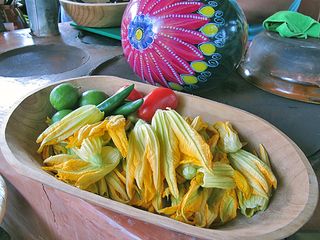
A few colorful, traditional pots and ingredients in Taller Zirita's outdoor kitchen. The ingredients include (from left) round, juicy Mexican limones (Key limes), dark green chiles serranos, bright red jitomates (Roma tomatoes), and just-picked green-and-gold flor de calabaza (squash blossoms).
This past May, Mexico Cooks! was honored to be part of the opening at Taller Zirita, Cynthia Martínez's incredibly beautiful cooking school in Morelia, Michoacán. At that time, we were pleased to show you photos of the exquisite environment of a Zirita cooking class. I'm excited to report that I have now been part of two Zirita culinary workshops, both offered with maestra Benedicta at the helm.

The delightful and talented Carolina Salazar Valle is part of the culinary teaching team at Zirita. In front of her on the counter, you see the printed recipes given to each attendee, as well ingredients for a few of the dishes that are her part of the day's workshop.
Our list of recipes for each of the days I participated at Zirita included this menu:
- chiles rellenos de uchepos (Poblano chiles stuffed with sweet corn tamales)
- corundas (traditional dried corn tamales with swiss chard and carrots)
- chorizo de Huetamo con salsa de mango (Huetamo-style spicy sausage with mango sauce)
- col de árbol dos maneras (wild cabbage prepared two ways)
- mole de queso de Benedicta (Benedicta's cheese mole)
- paquesos (sweets for dessert made of ground wheat and piloncillo [Mexican brown sugar cones])
Our workshop group, divided in two parts, prepared all of these traditional Michoacán delicacies and then enjoyed platefuls of everything we had prepared as our marvelous comida (main meal of the day).
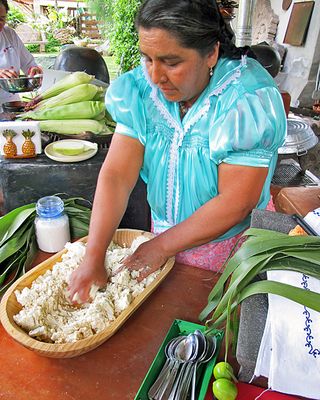
Maestra Benedicta showed our group how to knead the masa (corn dough) we used to prepare corundas. The masa is kneaded with grated, aged Cotija cheese, salt, shredded fresh acelgas (Swiss chard), and finely diced fresh carrots. She said, "Watch and listen. The masa will speak to you when it's ready to use." She was right: when she had kneaded the masa enough, it began to squeak as it pulled away from the bottom of the batea (wooden bowl). We carefully cleaned both sides of long corn leaves (right side of photo), used to wrap the corundas. Maestra Benedicta told us that there were two different sides to a corn plant's leaf: one side is smooth, the other is fuzzy. The balls of masa that are transformed by steam into corundas are placed on the smooth side.
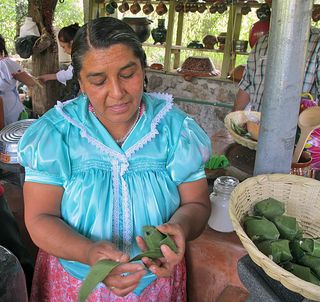
Maestra Benedicta wraps a ball of masa into the corn leaf. Each corunda can have three, five, or seven picos (points) which are formed by the way the corn leaf is wrapped. It's rare to see a corunda with seven picos, but maestra Benedicta has the necessary wrapping skill.
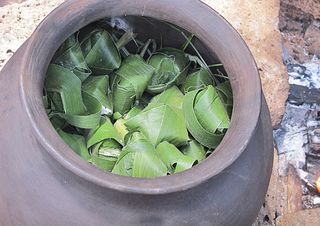
The corundas are stacked in their clay pot to steam. The lid will be a clay bowl that fits snugly into the pot opening. Maestra Benedicta does not use a vaporera (steam pot). Instead, she places a bundle of very small pine branches at the bottom of this clay pot, then a cushioning layer of the leftover ribs ripped lengthwise from the center of each of the corn leaves, then the water for steaming, then the corundas. Nothing goes to waste in her kitchen: everything has a use.

Fluffy, hot-out-of-the-pot and freshly unwrapped corundas con acelgas y zanahorias, served with a molcajete-made sauce. The molcajete is a three-legged volcanic stone mortar which is used with its own volcanic stone tejolote (pestle).

While the corundas steamed in their clay pot, Carolina taught us to make chorizo de Huetamo con salsa de mango. We ate this dish spooned onto crisp corn tostadas for a simple, spicy, and delicious appetizer.

One group of students prepared col de árbol two different ways, cooked (in this photo the potful has just been put on the fire) and as a raw salad with vinegar and crumbled cheese. Both preparations were magnificent.

Elvira, one of maestra Benedicta's daughters, minds the cooking fire; her own daughter Imelda is at her side. Many traditional Purépecha cooks continue to cook outdoors over a fragrant wood fire. Special long stones form the parangua (sacred cooking area); smaller stones form the fogón (support for the pot).
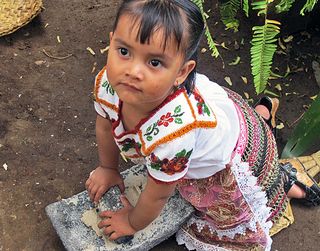
A Purépecha girl is never too young to learn ancient techniques: maestra Benedicta's two-year-old granddaughter Imelda has her own miniature metate y mano (grinding stone and rolling pin made of volcanic rock) and is learning to grind corn for masa by watching and imitating her grandmother and her mother. Maestra Benedicta learned these same techniques from her grandmother. The Purépecha kitchen has always been taught by oral tradition, recipes and techniques passing from grandmother to daughters and from a mother to her own daughters.
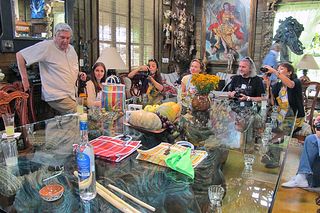
Our class on September 27, 2012, was made up of 17 professional journalists from all over the world. They were visiting Morelia for the 2012 Feria Internacional de Turismo Cultural.
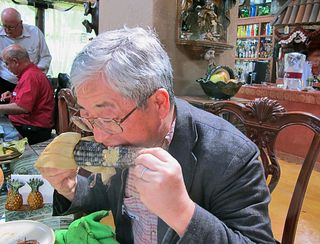
Professor Masaya Arakawa was visiting from Takarazuka City, Hyogo, Japan, to learn more about Michoacán cuisine. He joined our class on September 13, 2012.
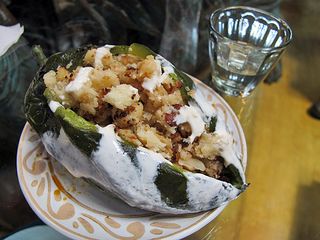
A chile relleno con uchepo–a roasted and peeled chile poblano, stuffed with diced leftover and toasted uchepos (sweet corn tamales) mixed with toasted almonds, raisins, and crema de mesa (Mexican table cream). To drink? Mezcal, artisan-made in Michoacán!
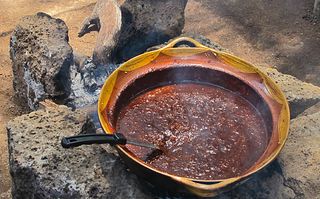
Maestra Benedicta's award-winning mole de queso, ready to serve. This mole is made with Cotija cheese and has a sharp, pleasant taste.

Paquesos for dessert: marble-size balls made of ground toasted wheat berries, piloncillo (Mexican brown sugar cones), canela (Mexican cinnamon), and a little water. We made the balls and then rolled them in a little reserved ground wheat.
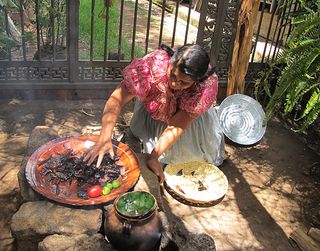
Maestra Benedicta toasts chile negro on the comal (in this case, a large clay griddle).
Saveur Magazine's Issue 149 is devoted entirely to Mexico's enormous array of food and drink. On page 80 of that issue, the editors write about Zirita Culinary Experiences: "Restaurateur Cynthia Martínez has created a shrine to the cuisine of small-town Michoacán. In outdoor kitchens over woodburning stoves, visitors learn to grind corn on a metate, press tortillas, and cook them on a comal, guided by practiced home cooks." One of a mere handful of Saveur-recommended cooking schools in Mexico, Zirita will give you a taste of everything you love about Mexico's cooking: its heart, its soul, and its deep, ancient flavors. Reserve your spot now for an upcoming class. There's nothing remotely like it anywhere else!
Zirita Culinary Experiences
Morelia, Michoacán
http://www.zirita.com.mx (website and classes offered in Spanish and English)
Looking for a tailored-to-your-interests specialized tour in Mexico? Click here: Tours
